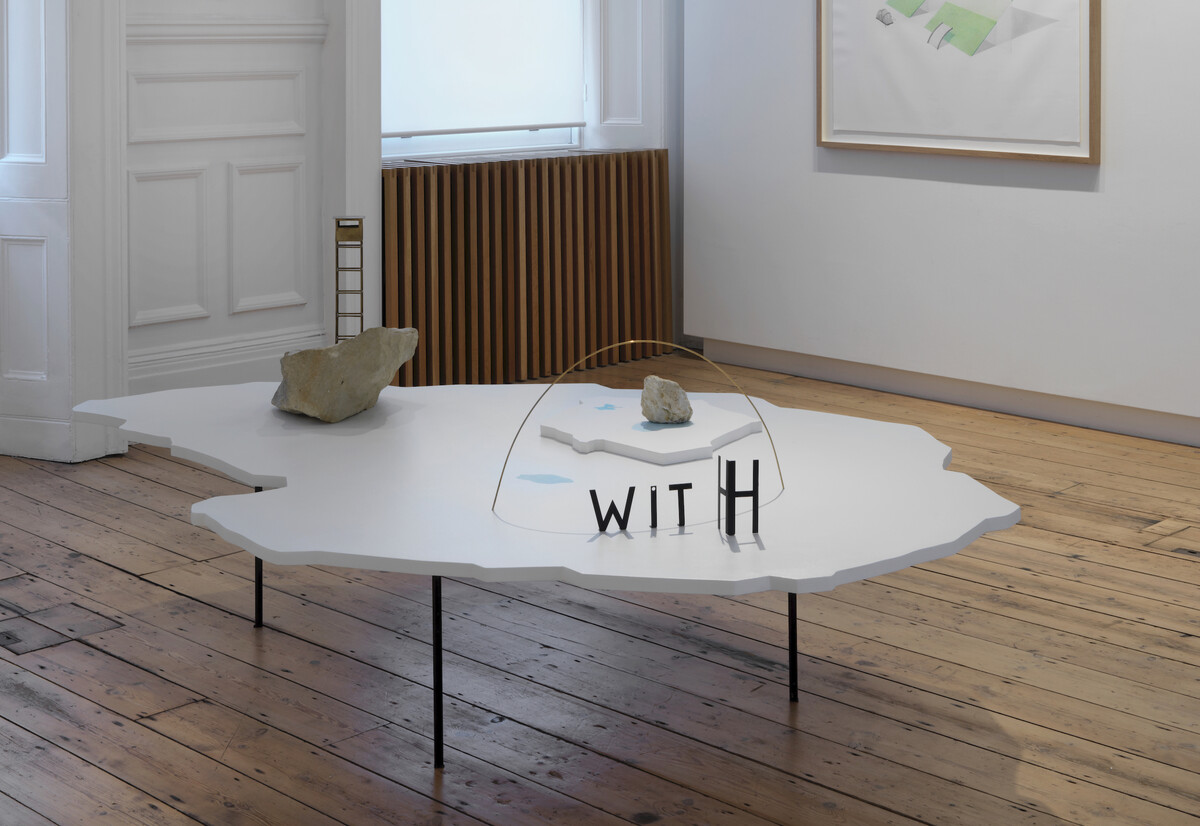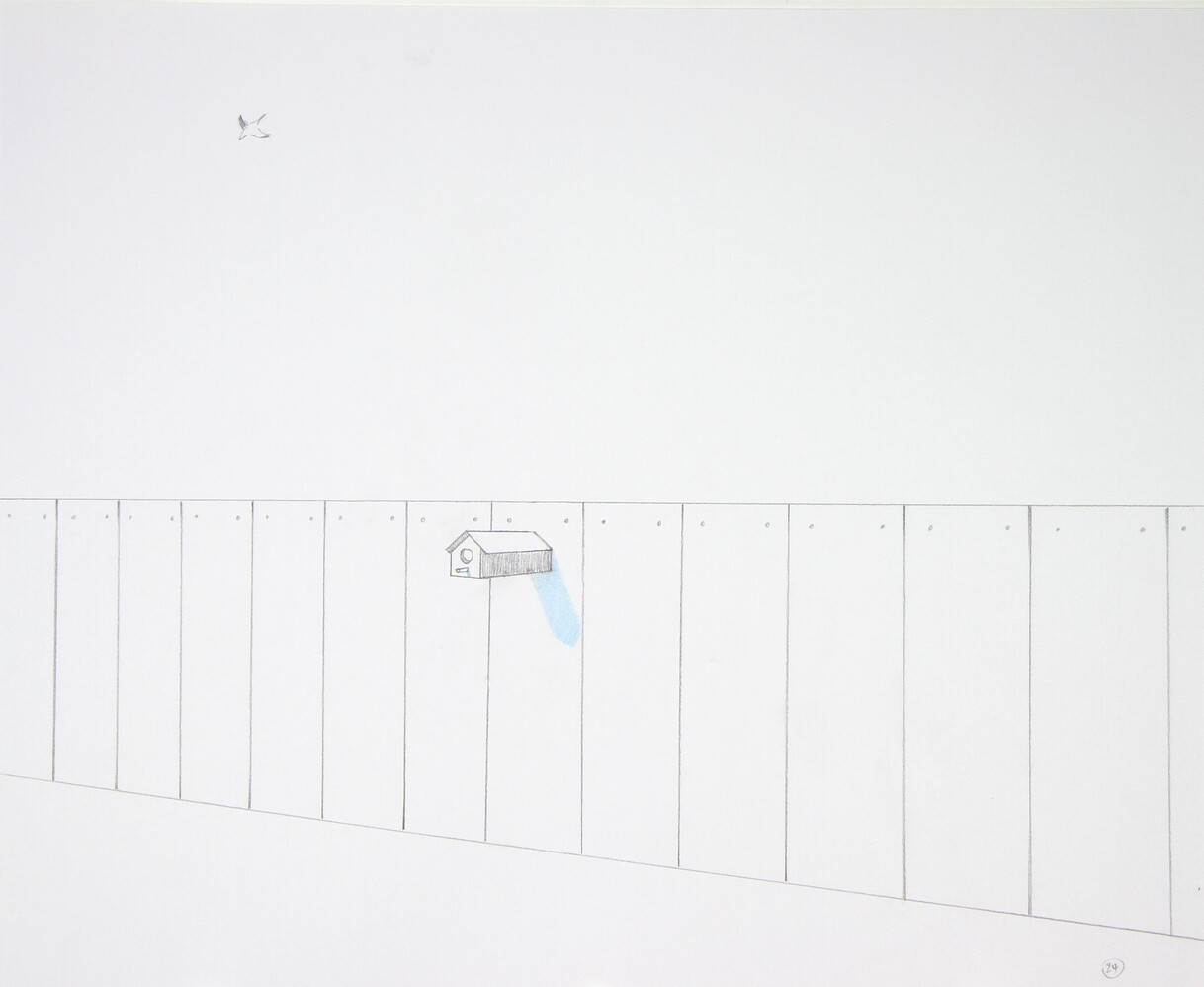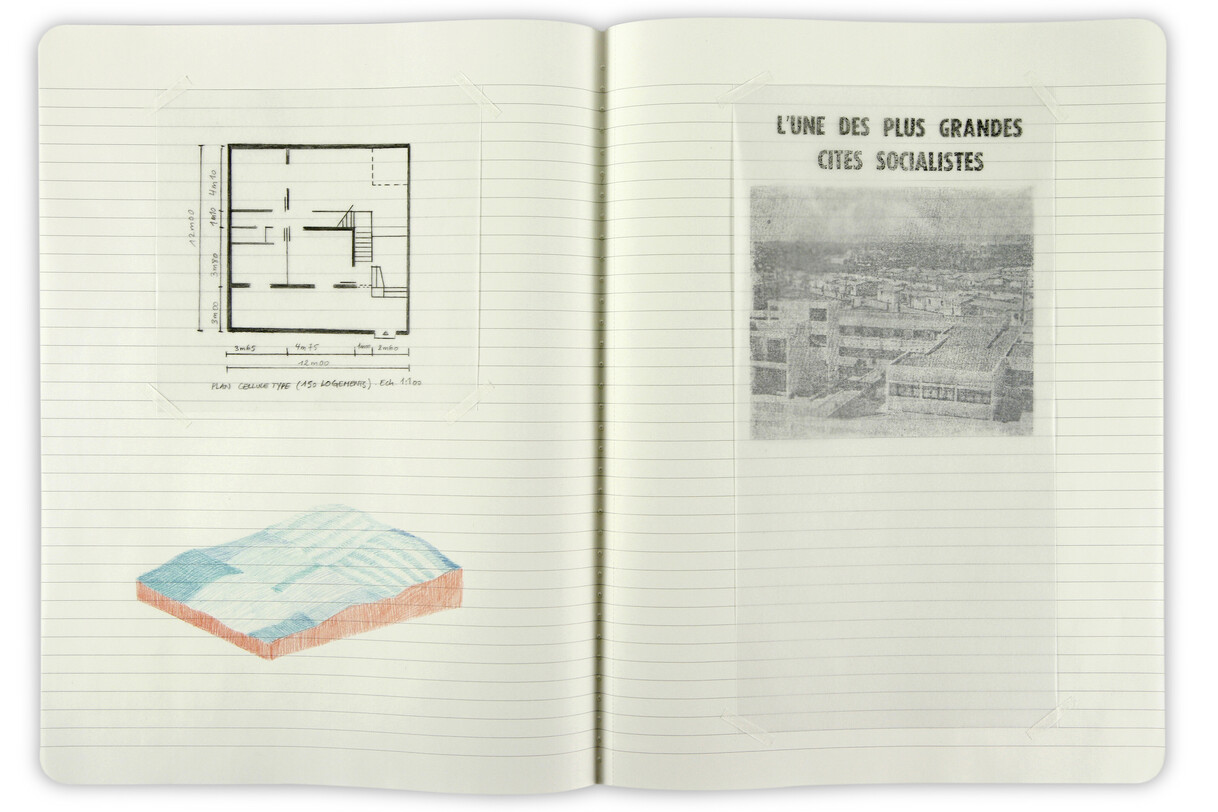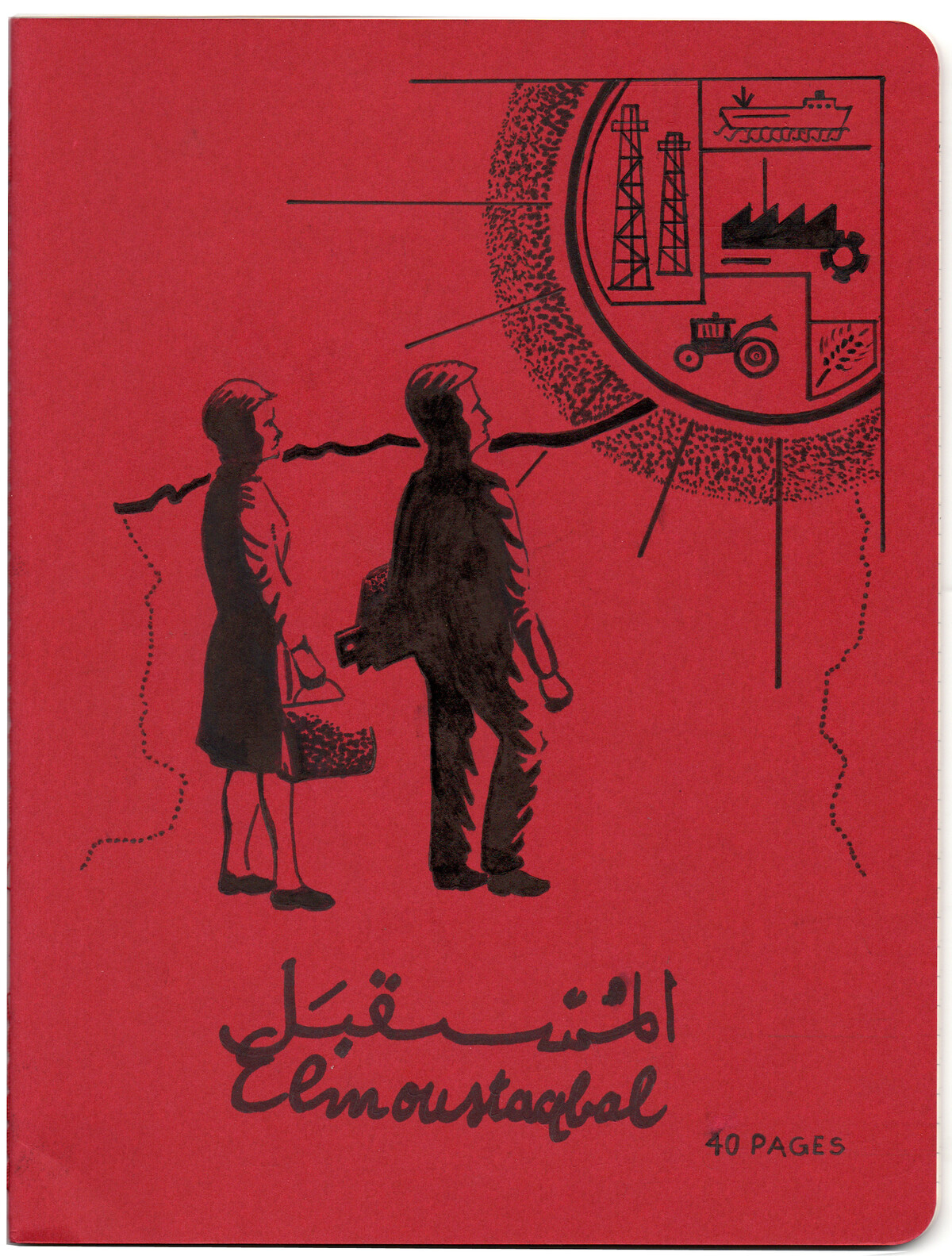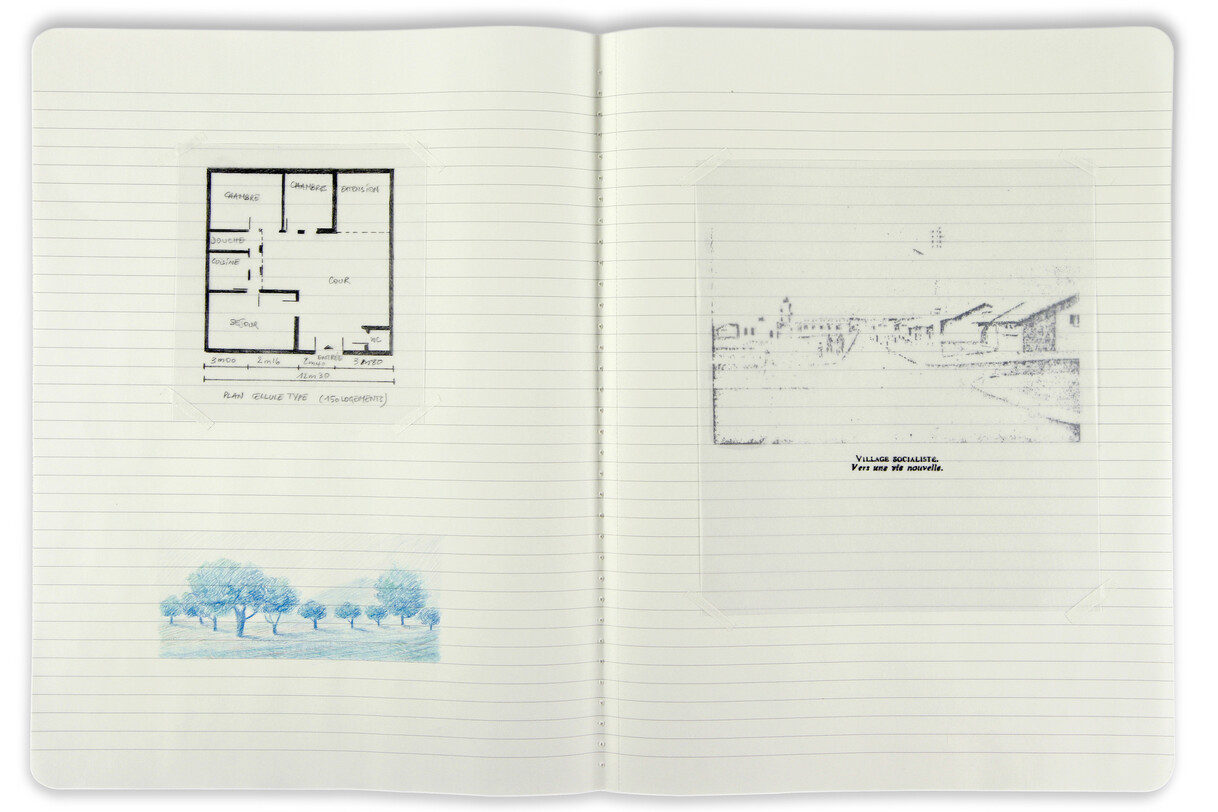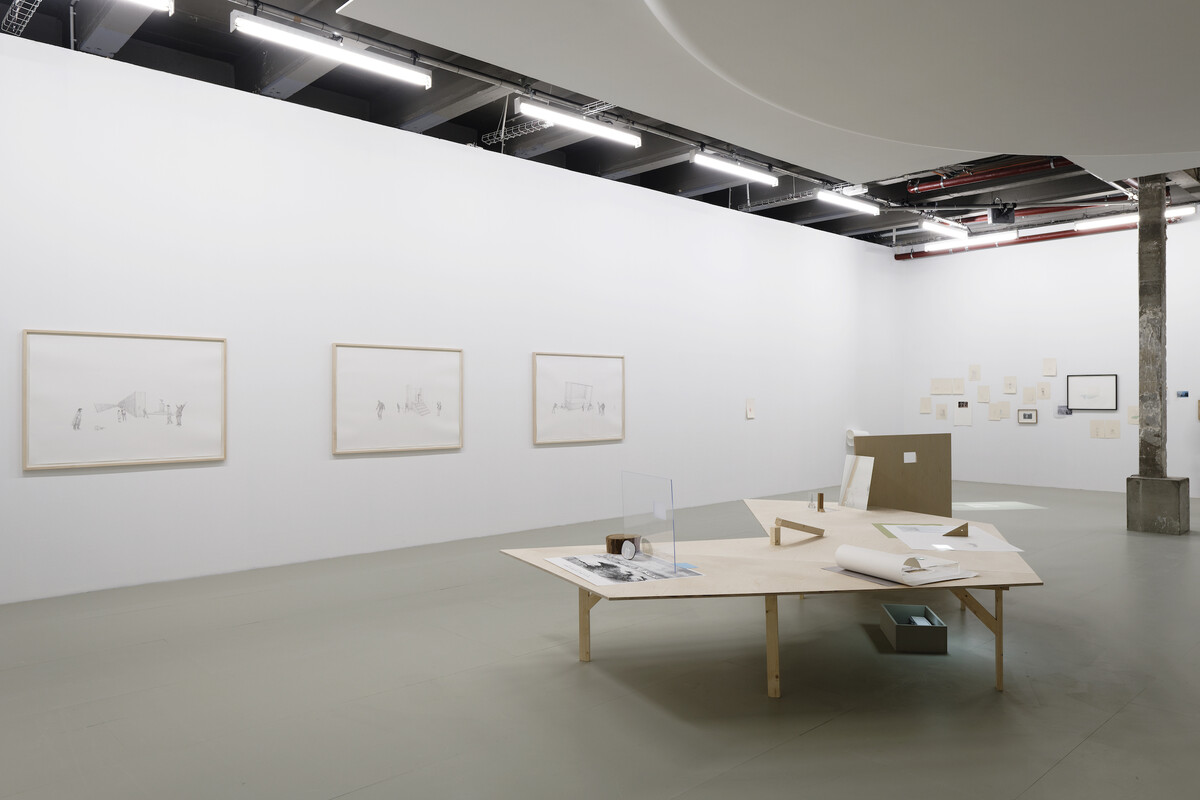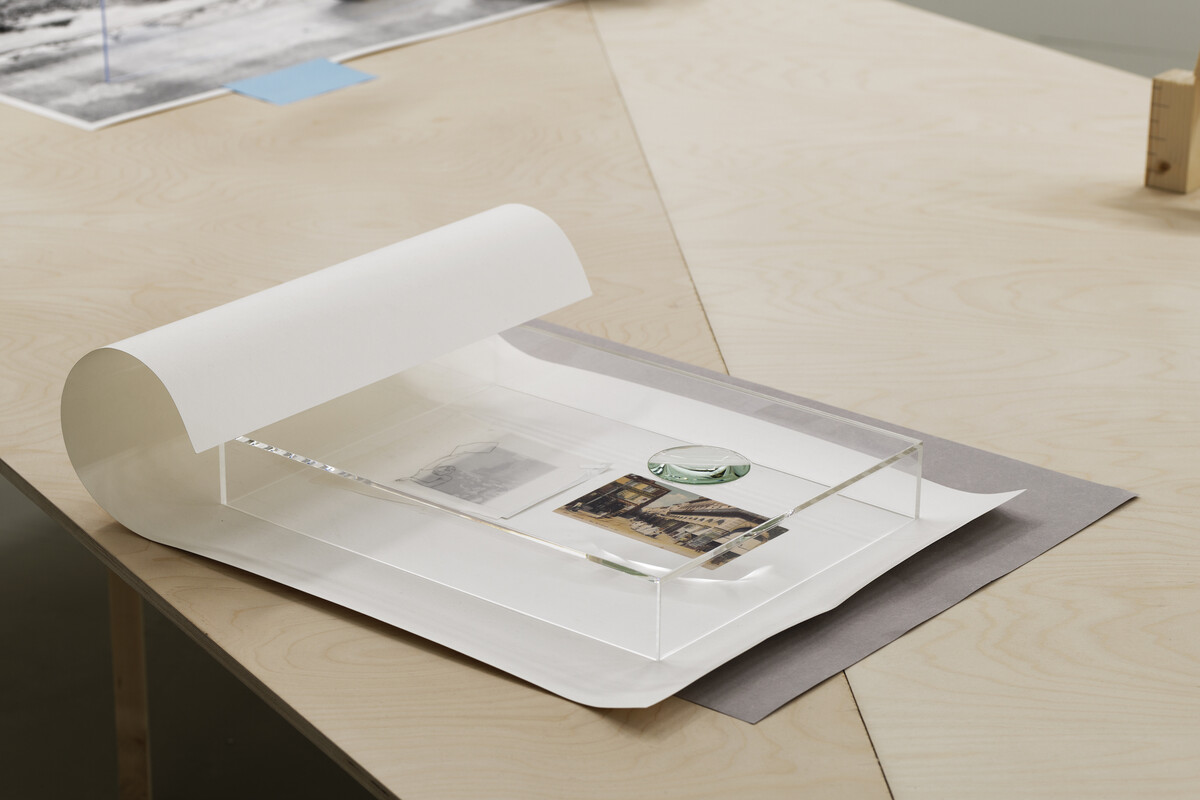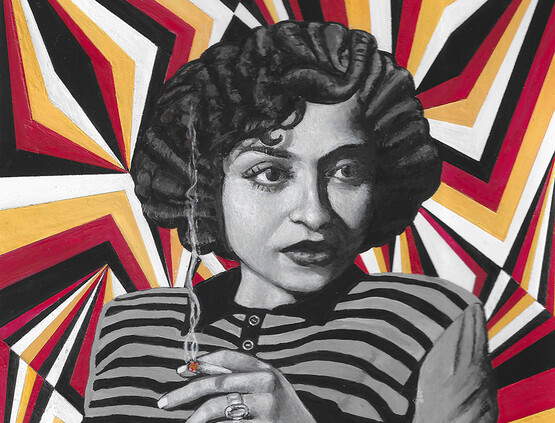Massinissa Selmani
by Roger Malbert • June 2023. In collaboration with Drawing Room, London • Article commission
The nomination of the Algerian artist Massinissa Selmani (b.1980) for the Prix Marcel Duchamp 2023 is an acknowledgment that a practice primarily grounded in pencil on paper can constitute a major contribution to contemporary art.1 In Selmani’s abbreviated aesthetic, substantial ideas are carried by the barest of means: a few cursory lines denoting a cloud, the outline of a figure carrying a blank flag, a portion of a monumental statue held aloft by a fluttering bird, a section of a miniature barrier embedded in a rock. Encompassing drawing, animation and sculpture, Selmani’s practice is characterised by a quiet uncertainty. His finely measured pencil-drawn images float on an empty expanse of white paper, usually with no hint of a setting in a particular location; they exist outside historical time and geographical space, and yet those constraining conditions of human life are precisely their subject.
Shadows play a defining role in Selmani’s images. Although ephemeral and immaterial themselves, they give substance to depicted phenomena and mark the passage of time. In drawings where spare delineation is the means of representing people and things, a lightly drawn shadow is often deployed to anchor an object, conjuring three-dimensional space without superfluous elaboration. In Une profondeur de ciel et de chemins #3 FIG. 1, for example, shadows are distinctly present under the bridge and flag, but also the rock, which is a mere outline, transparent against the grass and yet grounded by a solid patch of shade.
That immaculate drawing is one of three sharing the same title. In this series FIG. 2 FIG. 3, themes of obstruction and control are suggested by impassable paths and broken bridges. Selmani’s imagery can be understood metonymically: a rock stands for the earth, a rectangle of grass for territory, a flag for nationhood, a cloud for freedom of movement. His recent small sculptural assemblage Even distances are continents FIG. 4 contains several of these visual tropes, translated into three dimensions. The map-like shape of the platform suggests a coastline or the borders of a country. On one side of this unidentified territory an observation tower is perched on a single rock. Across from it, a smaller stone occupies its own diminutive portion of land and nearby the word ‘without’ is printed on top. This is placed in dialogue with another, much larger ‘WITH’, which is sculptural and stands upright, mirroring the structure of the tower. Such ironies serve to deflect from a didactic reading of the walls, fences and observation towers. There is clearly a political message – nationalism and the dehumanisation of the outsider or stranger are among the artist’s overriding concerns – but there is also, as he puts it, ‘a metaphysical or oneiric dimension’.2
Selmani’s absurdist humour is particularly evident in his looped animations, in which a single action is gently repeated in a perpetual cycle of quiet futility: a bird flies into a birdhouse fixed to a wooden fence, before emerging from the back and re-circling FIG. 5 FIG. 6; the shadows of a plane and a maple tree intersect as the plane flies overhead FIG. 7; a man in a pit holds up a microphone to a giant on-screen image of a uniformed general, who repeatedly raises and lowers his hands FIG. 8. These hand-drawn, silent, stop-frame animations are deliberately primitive, recalling the action of flicker books. The artist’s delight in graphic games of illusionism can be traced back to his early love of cartoons, most notably The New Yorker’s illustrator Saul Steinberg and his paradoxical play with pictorial space. That Selmani remains committed to the humble media of pencil on paper or tracing paper may be taken as evidence of his allegiance to such graphic traditions, the succinctness of which he takes to new heights of philosophical and political acuity. He can say everything he needs to say with these simple tools and the empty expanse of paper is the firm ground on which any edifice can be built. The precision with which he constructs his images, his paring down of each motif to the minimum, gives them a clarity and resonance that exceed their modest size and seeming reticence. They are as concise and exactly placed as a poem on the page.
Many of Selmani’s images are derived from documentary sources, situating them decisively in the realm of fact and everyday, lived reality. He traces the outlines of figures from newspaper photos, extracting from their context and the captions that would explain their actions. Nevertheless, they retain their potency as evocations of human effort, struggle or resistance. Yet they are disconcertingly ambiguous and elusive. The artist cites as a source of inspiration the Belgian Surrealist poet Paul Nougé who, in a series of enigmatic photographs taken in 1930, represented mysterious actions: ‘actions carried out on an object’ by the ‘suppression’ or ‘modification’ of that object, for example two men mimicking the gesture of clinking glasses but with their hands empty, or a group of people gathered in a room staring transfixed at a blank wall.3 Similarly, Selmani’s elimination of elements that would make sense of an image renders the familiar strange and mundane actions inexplicable.
At the core of Selmani’s practice is the fusion of documentary and fictional modes. Behind his now extensive body of drawings, collages, sculptures and animations of imaginary scenes, there are two archival research projects that illustrate his method of navigating between fact and fiction. It is worth considering them in some detail, as they provide a key to his broader concerns and overall strategy. Both projects are concerned with historical events, relating to land and territorial policies in colonial and postcolonial Algeria. In both, drawing plays a pivotal role as a metaphorical tool of research, a way of interpreting history ‘subjectively’ – not to elicit objective facts but to open up meanings that might otherwise not come to light. In an interview with Kate Macfarlane, Co-director of Drawing Room, London, Selmani cites Susan Sontag’s writing on Francisco Goya’s Disasters of War (1810–20). Despite his famous caption ‘Yo lo vio’ (‘I saw this’) on plate 44 from the series, none of Goya’s prints has an identifiable location; they are mostly set in a barren no man’s land bereft of human landmarks. Sontag writes, ‘Goya’s images are a synthesis. They claim: things like this happened. In contrast, a single photograph or filmstrip claims to represent exactly what was before the camera’s lens. A photograph is supposed not to evoke but to show’.4 Commenting on Sontag’s words, Selmani remarked: ‘I am very interested in this nuance. I do not try to show or demonstrate, but to construct a narrative that summons absence to be filled by the imagination and memory’.5
In 2015 the curator Okwui Enwezor invited Selmani to participate in the 56th Venice Biennale exhibition All the World’s Futures. One of the works that the artist presented was 1,000 Villages FIG. 9, which explores a period in Algeria’s post-independence history when, following the nationalisation and redistribution of land, the socialist government embarked on an integrated programme of agrarian reform. To improve rural living standards one thousand socialist villages were to be constructed across Algeria, with modern amenities – running water, plumbing and electricity – and facilities including schools, health clinics and mosques. These utopian villages were partly modelled on soviet cooperatives and were intended to engender a spirit of social solidarity. The first was inaugurated in 1972 and the plan was to complete one thousand within a decade. However, by 1981 only 171 had been completed, with a further three hundred under construction, and the programme petered out.6
The model was flawed in a number of ways: the imposition of standardised urban designs made little allowance for peasant household lifestyles; kitchens were designed for cooking standing at a stove, when traditionally Algerian women sit to cook; the floors were laid in unforgiving concrete and the walls constructed of breeze blocks, whereas earth floors and mud walls are cool in the summer and retain warmth in winter; the small interior courtyards provided no space for cooking outdoors or keeping livestock; and windows opened onto the streets, with no allowance for privacy. So much seemed poorly conceived, without sufficient consultation with the rural population they were intended to serve. Over the following years – during which Algeria experienced a fierce civil war – this ambitious programme of social reform was quietly forgotten.7
Selmani recalls hearing about the socialist villages project when he was growing up, but never saw any evidence of it. He asked his father about it after reading an article in the Algerian newspaper El Watan: ‘Both intrigued and amused by my question, he replied that he remembered the Agrarian Revolution very well, but the 1,000 villages echoed like an old rumour in his memory. His answer motivated me to dedicate a body of work to the project; it was obvious that I had to sound out this “rumour”’.8 It is this kind of elusive history – hovering between vague, unsubstantiated recollections and official narratives fabricated to cast the government in the best possible light – which appeals to Selmani.
In the course of his research into the socialist villages, Selmani met the architect, urban planner and sociologist Djaffar Lesbet, who had worked on the project as a young man and subsequently written his doctoral thesis on the subject. He shared his archive of photocopies of press clippings and other printed material with the artist, who used them to construct his visual narrative. The photocopies were degraded to various degrees, some so faded that the image had almost vanished, leaving only the caption legible. This seemed to epitomise the phantasmic nature of the subject, and Selmani organised his display of photocopied archival material so that the photographs progressively faded into obscurity. The work comprises pages of a school exercise book, which Semlani modified to look like the kind that he remembers using as a child. His illustration on the cover FIG. 10 shows an archetypal couple looking optimistically towards a sun emblazoned with symbols relating to industry, agriculture and trade, captioned with the words ‘The Future’. 1,000 Villages was displayed in a vitrine, with the cover and twenty loose-leaf double-page spreads laid out alongside each other. Each spread follows a similar format: on the left, Selmani has drawn floor plans of the houses provided by Lesbet and below it is a ‘fictional topographical sketch’ in coloured pencil of a section of landscape or a farmyard animal.9 On the right-hand page he has included a photocopied image of the villages taken from newspaper articles, transferred with its caption to tracing paper. The caption of the final image, on the twentieth spread, faded to a ghostly trace, reads: ‘vers une vie mouvelle’ (‘towards a new life’) FIG. 11.
Selmani continues to pursue research into the socialist villages, in collaboration with the curator and writer Natasha Marie Llorens, which will result in another chapter in his process of ‘fictional documentation’. The relationship of actual historical research and documentation to Selmani’s artistic project is oblique. His purpose is to create an allusive imaginative zone where politics and poetics coalesce. His drawings of imaginary portions of landscape – hillsides, valleys, woodlands or desert – become the basis for a recurring motif in his subsequent work: the unidentified patch of terrain.
1,000 Villages stimulated Selmani’s interest in the history of social struggle in Algeria during the colonial era. His second research project was an investigation into three interrelated nineteenth-century uprisings. In 1871 the famous Communard and revolutionary anarchist Louise Michel was fighting on the barricades in Paris. In the same year in Algeria, the biggest revolt against the French colonists since the conquest in 1830 occurred; named after the Mokrani brothers, it spread from the Kabylia region in the north across the country. Both insurrections were violently suppressed and the instigators, including Michel, were deported to the French penal settlement in the Pacific colony of New Caledonia. The Kanak people of New Caledonia were hired to guard the prisoners. However, they too had their grievances against the colonisers, who had displaced them from the most fertile land, and in 1878 they rebelled, only for their insurrection also to be forcibly suppressed. Michel was one of the few French prisoners to support them. Two years later an amnesty for the French political prisoners was granted and she returned to France, where she continued to agitate, lecture and write. She was again imprisoned, was briefly held in a mental asylum and then lived in exile in London, where she opened an international anarchist school for the children of political refugees.10 She travelled and lectured internationally, including in Algeria in 1904, shortly before her death. She was exceptional among French revolutionaries at that time in expressing sympathy with the Algerian anti-colonial struggle.
Selmani was intrigued by the story of the Algerian lecture tour and he consulted the documentalist Clotilde Chauvin, who has written a book about Michel’s time in Algeria.11 Working together, they devised a research trip to New Caledonia and Algiers. No record seems to exist of Michel’s lectures – in which she is said to have denounced religion, militarism and colonial violence – but Selmani discovered, by chance, a poster announcing one of them depicted in an old photographic postcard of a street corner in Algiers. This became a key item in his exhibition Ce qui coule n’a pas de fin (That which flows has no end) at Palais de Tokyo, Paris, in 2018 FIG. 12, which was curated by Yoann Gourmel.
The exhibition was composed in three sections and featured materials laid out like clues in a detective story. The centre was conceived of as a zone of ‘fictional tension’, with drawings of documentary material, maps and photographs representing the three insurgencies, the postcard FIG. 13 and small wooden sculptures arranged on a long table. In his representations of the Paris Commune, Selmani focused particularly on the toppling of the Vendome column. This cataclysmic event, instigated by Gustave Courbet (1819–77) – for which he paid heavily, being driven into exile in Switzerland, where he died – was the basis of the central motif in the exhibition: overturned monuments and architectural structures. On the wall behind the archival display were three large framed drawings, one of which depicted a large stack of archival shelves in the Musèe de l’Homme, Paris, tipping over, juxtaposed with a portrait of the Kanak chief who led the revolt in 1878. He was captured and killed and his head was taken as a trophy to Paris, where it was stored in the museum, until its ceremonial return to New Caledonia in 2014.
The third section of the exhibition consisted of drawings loosely arranged, as though on the studio wall FIG. 14. Some were framed while others on tracing paper were lightly affixed to the wall with masking tape, suggesting a provisional hang: an incomplete process. But this sense of flux could have been a deliberate ploy to unsettle the assumption of a fixed and stable meaning. ‘I am neither a historian nor a researcher’, Selmani has declared. ‘I did not intend to remind or educate people about the historical facts of these revolts. That is not my role. I try instead to show the unfathomable, to build a network of associations between ideas and forms, and to think of art for what it does to us rather than what it tells us’. He continues:
As an artist, part of my work revolves around the question of how to think through these problems. It’s about taking a step back; subjects are only a pretext for drawing. Drawing helped me first to get out of my surroundings and then later to understand them. This way of working is linked to a set of practices I developed over the past few years around drawn forms that fall between comic and tragic registers, and around drawing as a documentary form. I was a teenager in the 1990s during the Black Decade when the front page of Algerian newspapers was often very difficult to look at. My first instinct, like many Algerians at the time, was to flip the newspaper over and skip to the cartoon section. I was very impressed by the cartoon, and I used to say that it really is the birth of a lot of things for me. Have a good laugh first, then come back to face the sensationalism of the front page and the horrific content of the inner pages. This early encounter shaped my way of working. I have a strong reluctance towards spectacular, overly explanatory forms. Those kinds of images evoke the feeling in me that after the first sensation has passed there is nothing left to read or understand.12
Drawing might be an escape route, a way of imagining an alternative reality, and at the same time a means of achieving change in the circumstances of one’s life. The paradox of engaging with the historical constraints and injustices of the world while insisting on a measure of detachment – ‘subjects are only a pretext for drawing’ – is one that Selmani, like every artist who values their imaginative freedom, has to negotiate.13 He does so with a subtle and ironic sense of his position as an artist whose work is especially vulnerable to reductive interpretation. Facts succumb to fiction.




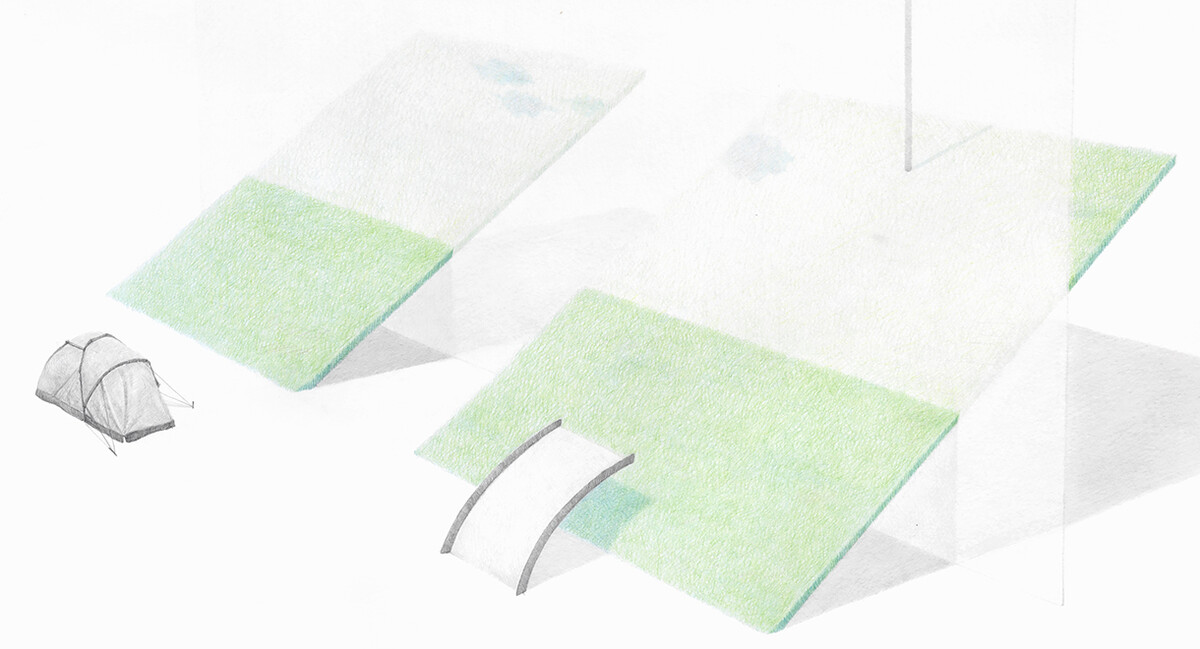
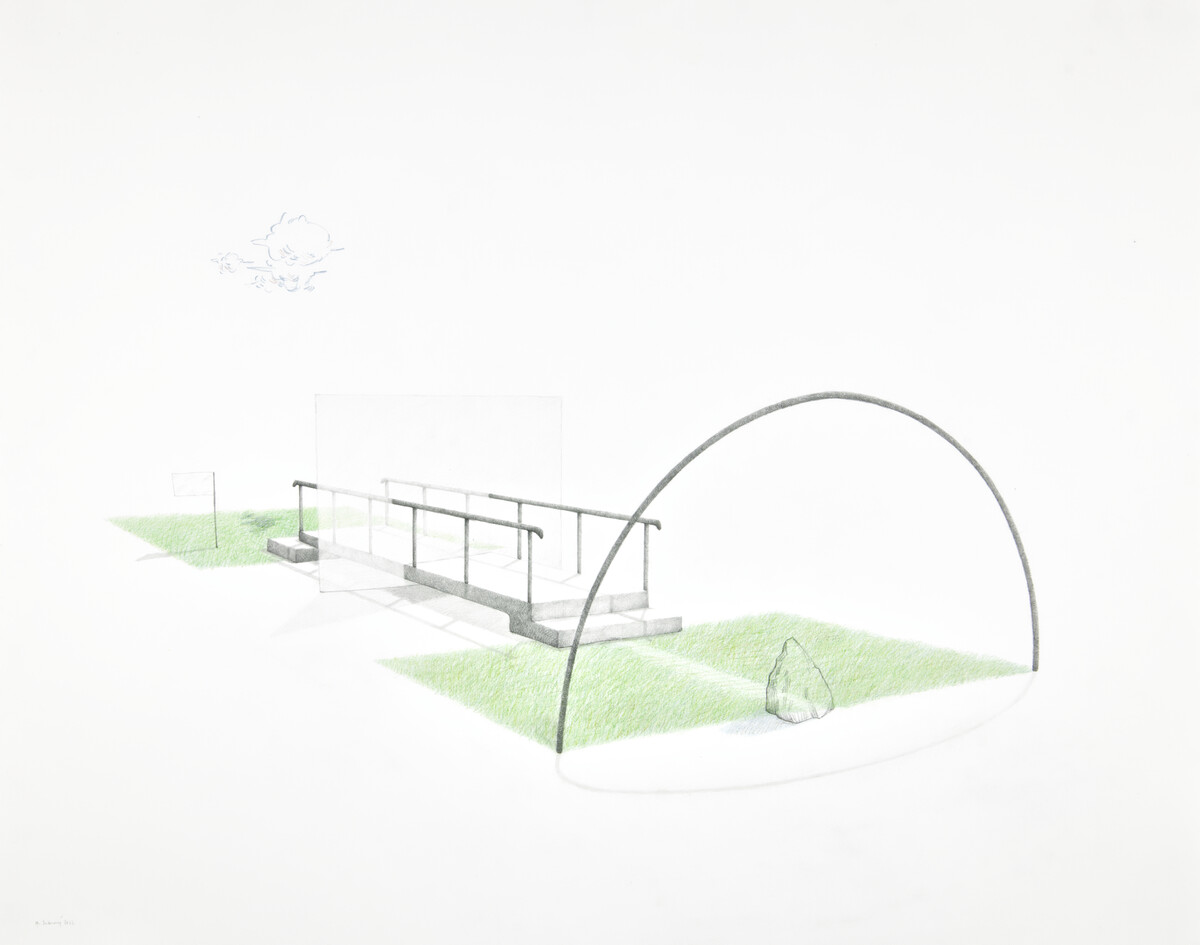
.jpg?ixlib=rb-0.3.5&ixid=eyJhcHBfaWQiOjEyMDd9&s=3566466d76117e29ffb4160a639748fb&auto=format&fit=crop&w=1502&q=80)

